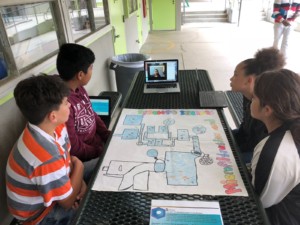How Did You Fail Advisory?

Our oldest son is arguably one of the smartest kids I have ever known (not bad for a pool that is close to the 15,000 student mark). While some would quickly dismiss this fact and perhaps label me as one of the dad’s with a “my kid is better than your kid” bumper stickers, I will explain further. When I share that he is a smart kid, my conclusion was not determined by grades or standardized tests, it was assessed by his ability to navigate a learning system that did not produce a lane where he could connect. It was also not solely based on a lack of desire to acquire new knowledge–he has been incredibly successful at teaching himself how to produce music, design logos and clothing and, most recently, write code. His greatest barrier was the unsuccessful navigation of school and the development of guiding relationships that in many ways function as a springboard to life.
As he stumbled through his experience, his grades were always passing, and as an educator-parent duo, his Mom and I continually danced with the balance of checking grades while providing autonomy for him to learn responsibility and connected accountability. He had never failed a class until the conclusion of the first semester of his junior year, when he failed advisory.
While we wanted to fuel his progress towards independence, we were diligent, even if at times covert, in our approach to monitoring his grades. During this same semester, he was very successful with his academics, earning 5 “A’s” and a “B.” After I read the report card, I quickly scanned the room for a hidden camera, looked at him, and asked, “How did you fail advisory?” His response was a fumbled utterance that ended with a genuine, “I really don’t know.”
Advisory as the Backbone of a Learning Model.
I am not naive. I knew that he understood why he “failed,” and also knew that there were many factors he needed to own and that school systems do not always fit each individual learner. Through further conversation, we discovered that he had not turned in portfolio products that were needed for his culminating project, which would be required for graduation a year and half later. Aside from trying to use my principal hat to figure out how their LMS system was able to make the advisory course credit-bearing on his transcript, we surrendered to the fact that it would be taken care of as he progressed with the requirements outlined within the advisory. Professionally, it resurfaced and fueled questions and reflections about advisory that continue to be a daily driver in a quest to transform learner experience. At face value, it reminds me of the 1,329 piece Millenium Falcon Lego set that I built with that same son years back. But as we broke it down, it did not need to be so complex. If I were to create a blueprint for an advisory program, it would look a little something like this.
Definition: What Does Advisory Mean to Your Community?
Regardless of how long you have been in your building, a non-negotiable lies in defining what “advisory” means to your learning community. Instead of defining what it has been, define what you would like it to be. Complete the task independently and get a diverse group of stakeholders (students, parents, community members) to complete the same activity. Once completed, engage in a conversation around why it is important, and begin to frame the “how” of designing the how it will be delivered.

Where Would We Start?
In design work of any type, I recommend starting with a base that can cast a wide enough net to shape variations of paths to travel. I have included my “advisory starter pack” below, with the caveat of my belief in designing what is best for the learners and community that you serve. As an additional side note, I would share that this is not all-inclusive, merely a beginning. Advisory, when done right, is alive with possibility, and nimble in integrating new learning that will inspire momentum towards the competencies your community creates.
The Adventures of Johnny Bunko, by Daniel Pink
I could, and have been close to creating a high school advisory curriculum solely based on the 6 lessons presented within this “last career guide you’ll ever need.” It explores the world of career by starting with the individual in pursuit of Drive behind finding purpose in what you would like to do with the “strengths, not weaknesses” you possess.
Linchpin, by Seth Godin
Mr. Godin, like Mr. Pink, made this selection difficult. I could have very easily infused Tribes or one of my all-time top five’s in Poke the Box, but the bottom line is I recommend arming yourself with a journey into the mind of Mr. Godin. It will add a layer of needed perspective as combat the “impossible,” with possibility.
Creating Innovators, by Tony Wagner
Subtitled as “The Making of Young People Who Will Change the World.” This book is formatted in a way that will frame out strategic ways of promoting innovation with students and provide professional learning aspects for the adults tasked with the charge.
Launch, by John Spencer and A.J. Juliani
Design Thinking should be integrated into every advisory program (and more) in the world. Launch, will get you started on the path of exploring design, creativity and “the maker in every student.”

Designing Your Life, by Bill Burnett and Dave Evans
I round out the list with a “playbook” to design your life. As Stanford D.School visionaries, this book will not only steer the design of meaningful advisory, but will provide equal inspiration for your own journey.
Master Schedule: It Doesn’t Need to Be a Labyrinth.
Without downplaying the complexity of the build, master schedules are sometimes over complicated by the individual (never recommended) or team (highly recommended) creating it. By recognizing advisory as something that is of value and providing it with equal presence, in of allocating time and resources, the ever-present search for time within the master schedule dissipates as it gains meaning as part of the scheduling equation. On the topic of frequency, I would restate the “balance” of importance presented above. If advisory is the vessel to promote social, emotional and academic development (SEAD), it should not be presented 20 minutes twice a week. It would be better received with increased meaning through an investment of time that matched the desired outcome.
Staffing: “Put me in, coach”.
Look at your entire staff and find ways to make meaning of everyone’s role. In one of the high schools I was a part of, we included multiple administrative and support staff members as part of the staffing equation. In addition to lowering the student to adult ratio, it also created a sense of ownership and belonging for all members of the staff member within our campus. As a teacher, advisory was always one of my favorite experiences as it set a stage to connect with students in areas that traveled beyond academics as an isolated focus. It fulfilled the coaching role where I felt at my best and allowed time to explore each individual student’s path while creating culture within our advisory “family.”
Student Grouping Structure: Multi-Age vs. Single Grade.
Prior to jumping into possible grouping structures, I would also add that there is no minimum age to begin advisory. In the same way that math, science, reading and writing progress as students age, the same application is beneficial, bordering on necessity, within an advisory setting. By front-loading students with the same skills that we require of our secondary learners, we successfully prepare them for success at the next level. In terms of multi-age or single grade level groupings, my preference, which is aligned with the rationale behind starting advisory as early as possible, is to model expectations for students prior to their arrival of the established competencies within your program. I could argue the latter, with an increased number of students who travel through advisory together, but the ultimate decision that needs to be made lies in the collaborative body designing the work.
Competencies, Curriculum and Lesson Design: Another Prep?
In my experiences, this is the Achilles heel of advisory. At best, I have seen programs built on a loose curriculum that leaves a great deal of autonomy for advisor interpretation and creation. Couple this with inadequate time and existing responsibilities and advisory becomes a free for all that often varies in its degree of consistent delivery and engagement. Instead, I would suggest, as with many components provided, that you treat it like you would any other content strand. Start with the end in mind. As you develop your graduate profile, look at the whole learner in regards to skills and abilities that students will know and be able to do. Transcend beyond graduation in preparing students for life and infuse these targets into the advisory competencies. Another successful add-on is to start with existing student leadership standards and add to them with intentional recognition of the community and students you serve.
Professional Development: They Didn’t Teach This in Teacher School.
Advisory was not a track in any of the teacher ed programs I have seen or experienced, but it is something that teachers have prepared for their entire life. In building professional development opportunities, recognize that the knowledge is in the room. Design the program in partnership with staff and instead of viewing this professional development as a requirement, view it as an opportunity for staff to lead new learning. This format of professional development reduces the anxiety of the job by shifting emphasis from unknowns to knowns and fuels collaborative growth of the whole.
Teachers are some of the most selfless individuals in the world, thoughtfully driven by supporting student navigation along the path to success in life. They are relationship building machines that in so many ways, care for students as if they were their own. Advisory has the potential of being a powerful accelerant and we at Getting Smart are here to help. If you are ready to make an impact and would like to explore design or coaching partnerships to innovate how you serve students, contact [email protected]
For more, see:
- The Role of Advisory in Personalizing the Secondary Experience
- Design Thinking and Its Impact on Education Innovation
- Unlearn to Learn: 6 Non-Negotiables of High Quality Professional Learning
- Next-Gen Advisory For Dropout Prevention
Stay in-the-know with all things EdTech and innovations in learning by signing up to receive the weekly Smart Update. This post includes mentions of a Getting Smart partner. For a full list of partners, affiliate organizations and all other disclosures please see our Partner page.








Joice
An eye opener. Thanks